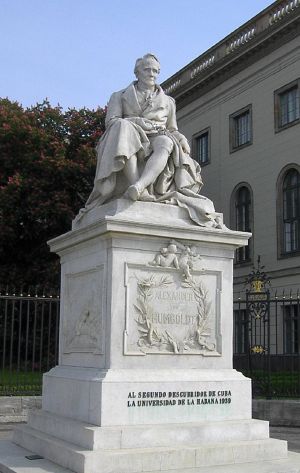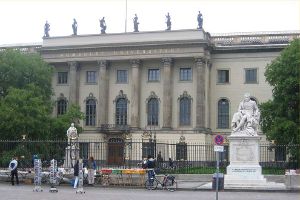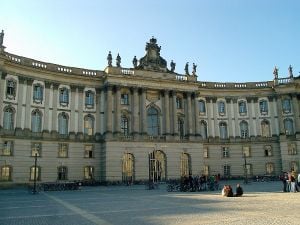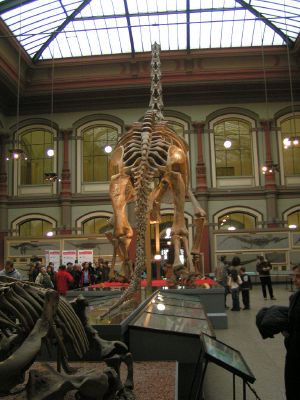Difference between revisions of "Humboldt University of Berlin" - New World Encyclopedia
(Started) |
|||
| Line 1: | Line 1: | ||
| − | {{Claimed}} | + | {{Claimed}}{{Started}} |
[[Category:Politics and social sciences]] | [[Category:Politics and social sciences]] | ||
[[Category:Education]] | [[Category:Education]] | ||
Revision as of 19:13, 19 June 2007
- "University of Berlin" redirects here.
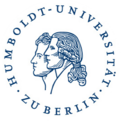 Latin: Alma Universitas Humboldtiana Berolinensis (older: Universitas Friderica Gulielma Berolinensis) | |
| Established | 1810 |
|---|---|
| Type | Public university |
| Location | Berlin, Germany |
| Website | http://www.hu-berlin.de |
The Humboldt University of Berlin (German Humboldt-Universität zu Berlin) is Berlin's oldest university, founded in 1810 as the University of Berlin (Universität zu Berlin) by the liberal Prussian educational reformer and linguist Wilhelm von Humboldt whose university model has strongly influenced other European and Western universities. From 1828 it was known as the Frederick William University (Friedrich-Wilhelms-Universität), later also as the Universität unter den Linden. In 1949, it changed its name to Humboldt-Universität in honour of its founder.
The university has been home to many of Germany's greatest thinkers of the past two centuries, among them the subjective idealist philosopher Johann Gottlieb Fichte, the theologian Friedrich Schleiermacher, the absolute idealist philosopher G.W.F. Hegel, the Romantic legal theorist Savigny, the pessimist philosopher Arthur Schopenhauer, the objective idealist philosopher Friedrich Schelling, and famous physicists Albert Einstein and Max Planck. Founders of Marxist theory Karl Marx and Friedrich Engels attended the university, as did poet Heinrich Heine, German unifier Otto von Bismarck, Communist Party of Germany founder Karl Liebknecht, African American pan africanist W. E. B. Du Bois and European unifier Robert Schuman. And one must not forget the great surgeon Johann Friedrich Dieffenbach in the early half of the 1800s. The university is home to 29 Nobel Prize winners.
The structure of German research intensive universities, such as Humboldt, served as a model for institutions like Harvard, Duke, and Cornell.
History
Third Reich
After 1933, it was, like all German universities, transformed into a Nazi educational institution. It was from the University's library that some 20,000 books by "degenerates" and opponents of the regime were taken to be burned on May 10 of that year in the Opernplatz (now the Bebelplatz) for a demonstration protected by the SA that also featured a speech by Joseph Goebbels. A monument to this can now be found in the center of the square, consisting of a glass panel opening onto an underground white room with empty shelf space for 20,000 volumes and a plaque, bearing an epigraph from an 1820 work by Heinrich Heine: "Das war ein Vorspiel nur, dort wo man Bücher verbrennt, verbrennt man am Ende auch Menschen" ("That was only a prelude; where they burn books, they ultimately burn people"). Jewish students and scholars and political opponents of Nazis were ejected from the university and often deported.
Post WWII
In 1946, the university opened again. The Soviet administration soon took over control of the university, relegating all students who didn't conform to Communist ideology. As a reaction, the Free University of Berlin was founded in 1948 in the Western part of the city. The communist party forced it to change the name of the university in 1949. Until the collapse of the East German regime in 1989, Humboldt University remained under tight ideological control of the Sozialistische Einheitspartei Deutschlands (Socialist Unity Party of Germany), or SED, which, by rigorously selecting students according to their conformity to the party line, made sure that no democratic opposition could grow on its university campuses. Its Communist-selected students and scholars did not participate in the East German democratic civil rights movements of 1989 to a considerable degree, and elected the controversial SED member and former Stasi spy Heinrich Fink as the Director of the University still in 1990.
Today
After the end of communism, the university was radically restructured and all professors had to apply for their professorships anew. The faculty was largely replaced with West German professors, among them renowned scholars like the art historian Horst Bredekamp and the historian Heinrich August Winkler. Today, the Humboldt University is a state university with a high number of students (37,145 in 2003, among them more than 4,662 foreign students) after the model of West German universities, and like its counterpart Free University of Berlin.
Its main building is located in the centre of Berlin at the boulevard Unter den Linden. The building was erected by Prince Heinrich of Prussia. Most institutes are located in the centre, around the main building, except the nature science institutes, which are located at Adlershof in the south of Berlin. The University continues to serve the German community.
Organization
These are the 11 faculties in which the university is divided into:
- Faculty of Law
- Faculty of Agriculture and Horticulture
- Faculty of Mathematics and Natural Sciences I (Biology, Chemistry, Physics)
- Faculty of Mathematics and Natural Sciences II (Geography, Computer Science, Mathematics, Psychology)
- Charité - Berlin University Medicine
- Faculty of Philosophy I (Philosophy, History, European Ethnology, Department of Library and Information Science)
- Faculty of Philosophy II (Literature, Linguistics, Scandinavian Studies, Romance Literatures, English and American Studies, Slavic Studies, Classical Philology)
- Faculty of Philosophy III (Social Sciences, Cultural Studies/Arts, Asian/African Studies (includes Archeology), Gender Studies)
- Faculty of Philosophy IV (Sport Sciences, Rehabilitation Studies, Education Studies, Quality Management in Education)
- Faculty of Theology
- Faculty of Economics and Business Administration
External links
- (German) (English) Humboldt University of Berlin Website
- (German) (English) History of the Humboldt University
- Humboldt University CityPanorama - Interactive 360° Panorama in front of the University
- (German)Professor Dietrich - Humboldt University of Berlin
Credits
New World Encyclopedia writers and editors rewrote and completed the Wikipedia article in accordance with New World Encyclopedia standards. This article abides by terms of the Creative Commons CC-by-sa 3.0 License (CC-by-sa), which may be used and disseminated with proper attribution. Credit is due under the terms of this license that can reference both the New World Encyclopedia contributors and the selfless volunteer contributors of the Wikimedia Foundation. To cite this article click here for a list of acceptable citing formats.The history of earlier contributions by wikipedians is accessible to researchers here:
The history of this article since it was imported to New World Encyclopedia:
Note: Some restrictions may apply to use of individual images which are separately licensed.
